I. Introduction
A. Definition of Alpine Ice Hacking
B. Importance of Ice Hacking in Alpine Environments
C. Overview of the Content
II. Understanding Alpine Environments
A. Characteristics of Alpine Regions
B. Challenges of Ice Climbing in Alpine Environments
C. Importance of Safety Measures
III. Tools and Equipment for Alpine Ice Hacking
A. Essential Gear for Ice Climbing
B. Specialized Equipment for Alpine Environments
C. Safety Gear and Its Importance
IV. Techniques and Strategies for Alpine Ice Hacking
A. Ice Climbing Basics
B. Advanced Techniques for Challenging Ice Conditions
C. Strategies for Efficient Progression
V. Safety Measures and Risk Management
A. Risk Assessment in Alpine Ice Climbing
B. Safety Protocols and Precautions
C. Emergency preparation and Rescue Procedures
VI. Environmental Considerations
A. Leave No Trace Principles
B. Minimizing Environmental Impact
C. Sustainable Practices for Alpine Ice Climbing
VII. Training and Preparation
A. Physical Conditioning for Alpine Ice Climbing
B. Mental Preparation and Focus
C. Skill Development and Training Programs
VIII. Notable Alpine Ice Climbing Destinations
A. Description of Iconic Alpine Routes
B. Tips for Planning an Ice Climbing Trip
C. Safety Guidelines for Specific Locations
IX. Conclusion
A. Recap of Alpine Ice Hacking Essentials
B. Encouragement for Safe and Responsible Ice Climbing
C. Looking Ahead: Future Trends in Alpine Ice Climbing
I. Introduction
A. Definition of Alpine Ice Hack.
Alpine ice Hacking is also known as alpine ice climbing relate to the challenging and breathtaking sport of soaring frozen waterfalls glaciers and vertical ice layouts in high altitude mountain environment. Unlike traditional rock climbing which focuses on scaling vertical rock faces ice hacking involves navigating vertical or near vertical ice formations using specific equipment such as ice axes crampons and ropes.
Ice hacking presents a unique set of challenges and rewards for climbers. It requires a combination of physical power technical skill and mental core to navigate icy domain and overcome barriers such as brittle ice un-stable conditions and unpredictable weather. Climbers use a variety of techniques including deviating ice axes kicking crampons into the ice and placing protection devices such as ice screws and anchors to secure themselves and their climbing partners.
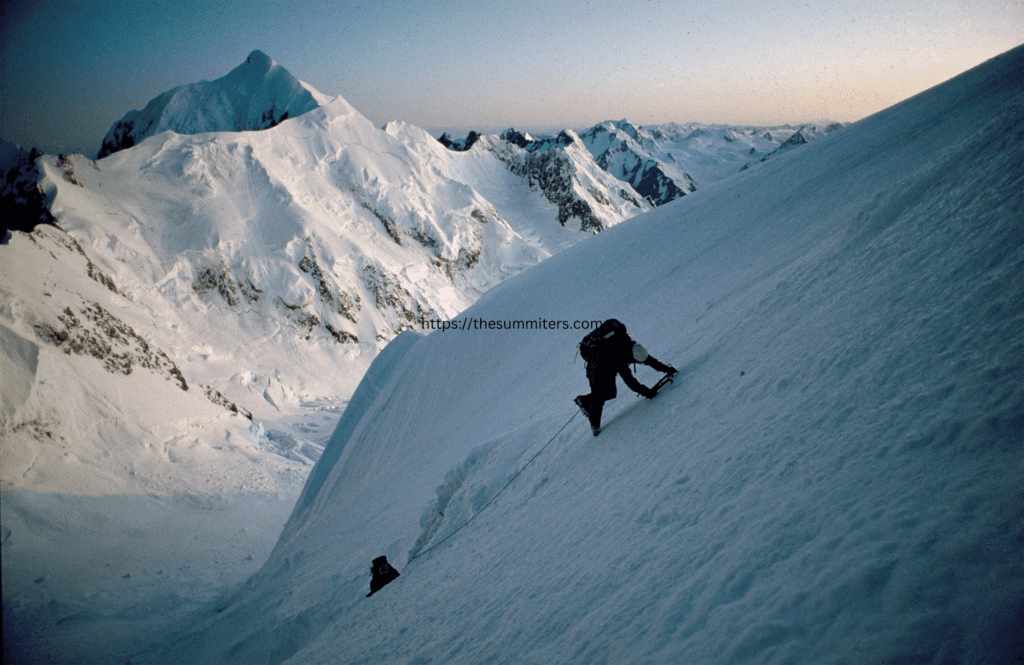
B. Importance of Ice Hacking in Alpine Environments
Ice hacking plays a significant role in alpine environments for several reasons
Exploration and Adventure
Alpine Ice climbing offer climbers the opportunity to explore remote and tough landscapes that are in-accessible by other words. It provides a sense of adventure and discovery as climbers navigate frozen waterfalls, glaciers and ascend vertical ice walls.
Physical and Mental Challenge
Ice hacking is a physically demanding sport that requires power persistence and flexibility. Climbers must also have mental toughness and problem solving skills to navigate complex realm and overcome obstacles. The combination of physical and mental challenges makes ice hacking a rewarding and encouraging pursuit for climbers seeking personal growth and self discovery.
Connection to Nature
Ice hacking allows climbers to connect with nature in a unique and familiar way. Climbing in alpine environment, intrigues climbers in the beauty and majesty of the natural world providing a sense of wonder and venerate for the mountains and the forces that shape them. It cultivates a deep appreciation for the fineness and resilience of the natural environment, inspiring climbers to become servants of the land and advocates for conservation and preservation efforts.
C. Overview of the Content
In this complete guide to Alpine Ice Hacking we will explore the fundamentals of the sport including equipment techniques safety measures and environmental studies. We will dig into the tools and gear essential for ice climbing in alpine environments discussing their functions features and importance. We will also examine the techniques and strategies used by climbers to navigate icy terrain including basic climbing skills and advanced techniques for approaching challenging routes. Additionally we will discuss the importance of safety measures and risk management in the ice hacking including evaluating hazards, planning routes, and responding to emergencies. finally we will explore the environmental impact of the ice hacking and the importance of practicing Leave No Trace principles to minimize our impact on delicate ecosystems. Whether you’re a beginner climber looking to learn the ropes or an experienced alpinist seeking new challenges this guide will provide you with the knowledge and skills you need to enjoy the thrill of Alpine Ice Hacking safely and responsibly.
II. Understanding Alpine Environments
A. Characteristics of Alpine Regions
Alpine regions are characterized by their high altitudes rugged realm, and extreme weather conditions. These environments typically occur at high elevations above the tree line where temperatures are freezing and foliage becomes poor.
Key characteristics of alpine regions include
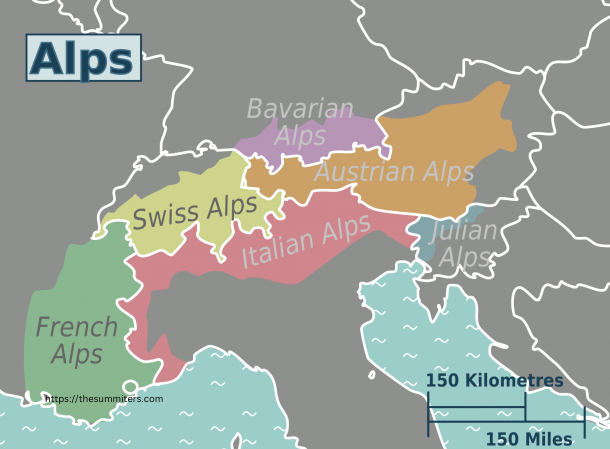
High Altitude
Alpine environments are being found in mountain’s regions around the world normally above the tree line at altitudes surpassing 2500 meters (8200 feet). The thin air at high altitudes offers challenges such as reduced oxygen levels increased risk of altitude sickness and decreased physical performance.
Rugged Terrain
Alpine landscapes are characterized by sheer slopes rocky surfaces, and broken peaks. The terrain can be irregular and unstable with steep, sloopy fields, and exposed cliffs presenting obstacles for climbers.
Extreme Weather
Alpine environments are subject to rapidly changing weather conditions including high winds heavy snowfall and sudden storms. Temperature fluctuation are common with daytime highs and nighttime lows uneven significantly. Climbers must be prepared for harsh weather conditions and be able to adapt their plans accordingly.
Glaciers and Snowfields
Many alpine regions feature glaciers and permanent snowfields which can offers both opportunities and challenges for climbers. Glacier trek requires specific equipment and techniques to navigate crevasses seracs and other hazards safely.
Fragile Ecosystems:
Alpine environments are home to a distinct range of plant and animal genre adapted to the harsh conditions of high mountains. These delicate ecosystems are sensitive to human impacts including stomping, soil corrosion, and pollution.
B. Challenges of Ice Climbing in Alpine Environments
Ice climbing in alpine environment suggests unique challenges for climbers due to the combination of technical field, unpredictable weather and remote sites.
Some of the key challenges include
Variable Conditions
Ice climbing conditions can vary prominent depending on factors such as temperature, humidity and sun exposure. Climbers must be prepared to encounter everything from brittle ice to sticky snow and fragile snow.
Objective Hazards
Mountains can be risky places with things like landslides, avalanches, and chunks of ice falling. Climbers need to be careful and think about these dangers. They pick safe paths, plan their climbs to avoid risky spots, and stay alert all the time.
Physical Demands
Ice climbing needs you to be really fit and strong. You need good balance, strong grip, and stamina to keep going. Climbers have to handle slippery ice slopes and carry heavy bags while climbing.
Technical Difficulty
In mountains, icy paths can be tough with tricky parts, like slopes that stick out, icy shapes called chandeliers, and thin ice layers. Climbers need to be really skilled and know how to use special tools like ice screws, cams, and pickets.
Isolation and Self-Reliance
When engaging in alpine climbing individuals often find themselves in remote and isolated areas far from any urban centers or emergency services. Therefore climbers must be self dependent and equipped to handle emergencies such as injuries, equipment to crashes, or unexpected weather changes without outside assistance.
C. Importance of Safety Measures
Given the essential risks of ice climbing in alpine environment safety measures are paramount for ensuring a safe and satisfying experience.
These measures include:
Risk Assessment
Before starting to climb up a Alpine rock, climbers should carefully guess the possible dangers and risks along the way. This includes things like avalanches, landslides, and the weather.
Proper Equipment
For staying safe while ice climbing, it’s really important to use good quality gear that’s well taken care of, This means using special equipment like ice axes, crampons (those spiky things for your boots), harnesses, helmets, and ropes.
Technical Skills
Climbers must retain the necessary technical skills and experience to safely navigate alpine trek and overcome obstacles. This includes mastery in ice climbing techniques, rope management, anchor building, and self rescue.
Communication
Effective communication is acute for coordinating with climbing partners, valuing route conditions and responding to emergencies. Climbers must establish a good communication system and signals before starting the climb.
Emergency Preparedness
Climbers need to bring important emergency stuff like first aid kits, communication tools (like radios or satellite phones), and gear to spend the night outdoors in case of an emergency (like sleeping bags or shelters). It’s also smart to have a plan for rescuing themselves or calling for help if they need it.
By making safety a top priority and being aware of the tough parts of climbing in the mountains, climbers can lower the chances of getting hurt and have a blast ice climbing. This way, they can make sure they get back home safely after their adventure.
III. Tools and Equipment for Alpine Ice Hacking
A. Essential Gear for Ice Climbing
Ice climbing like any other adventure sports requires specific gear to ensure safety and efficiency.
Here are the essential items every ice climber needs:
Ice Axes
Ice axes are the main tools for ice climbing. One end has a curved point for grabbing onto the ice, and the other end can either have a flat blade for pureeing ice or a hammer for driving in steps. Nowadays ice axes are made to be light, tough, and work really well.
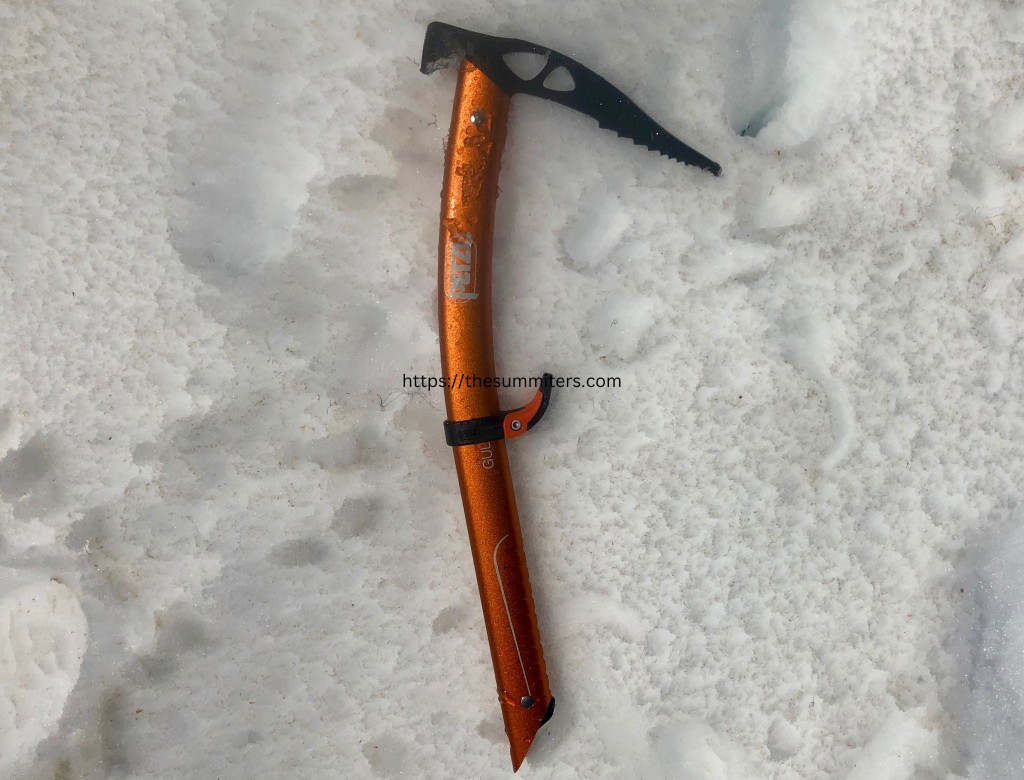
Crampons
Crampons are spikes made of metal that attach to the climber’s boots providing grip on ice and hard surfaced snow. They featured sharp points on the bottom to grip the ice and horizontal front points for stability while climbing. Crampons come in different styles and configurations including step in and strap on models.
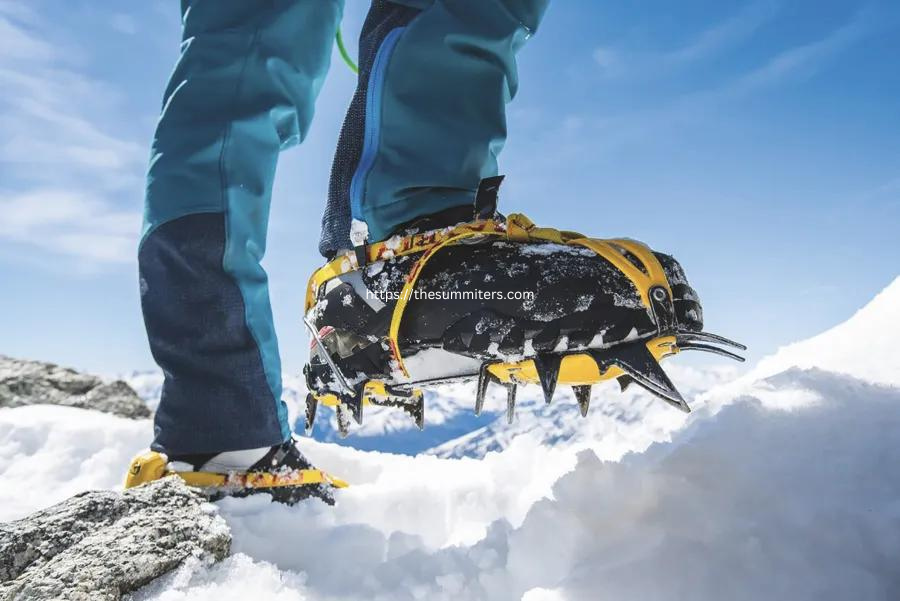
Harness
A climbing harness is an important gear for keeping the climber inclined to the rope and giving support if they fall. It’s like a belt with packing around the waist and legs to make it comfortable during long climbs. You can adjust it to fit just right with buckles. Also it has bands where you can hang stuff like ice screws and carabiners.
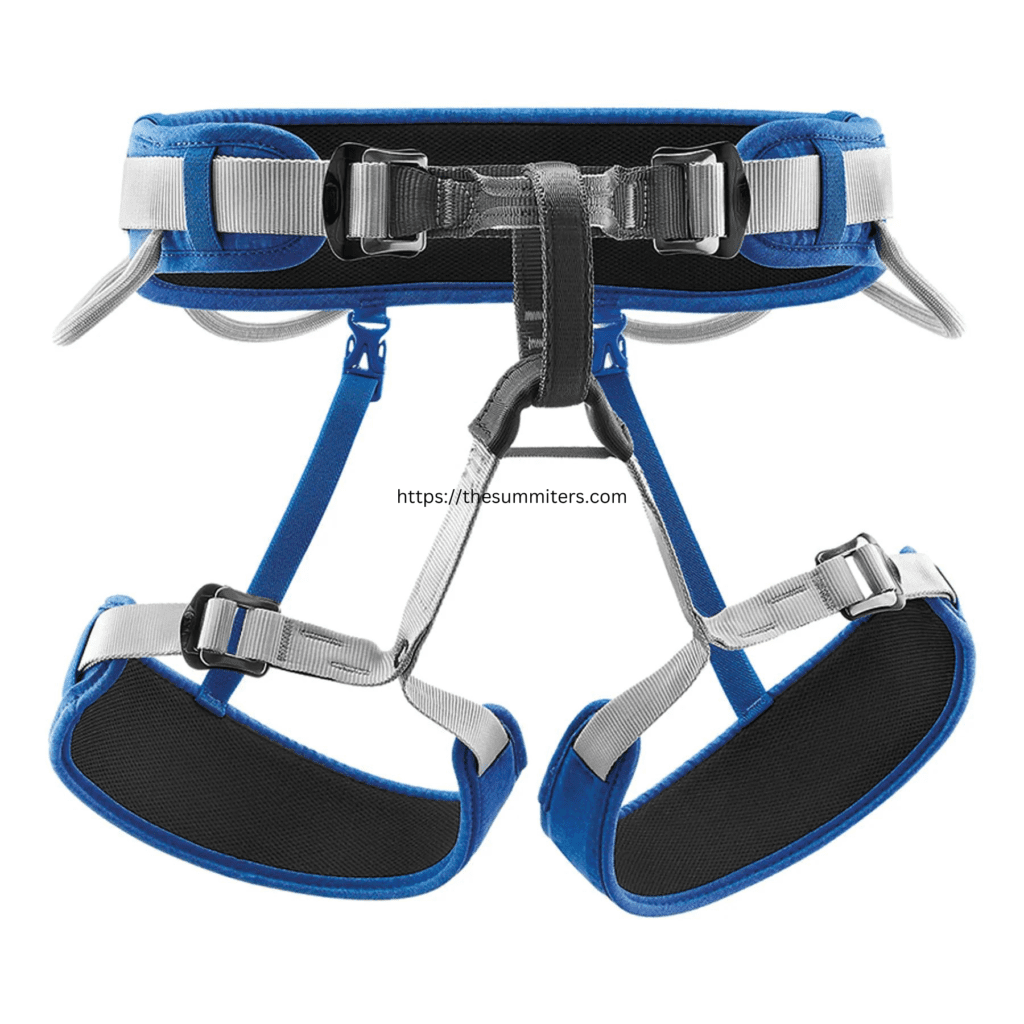
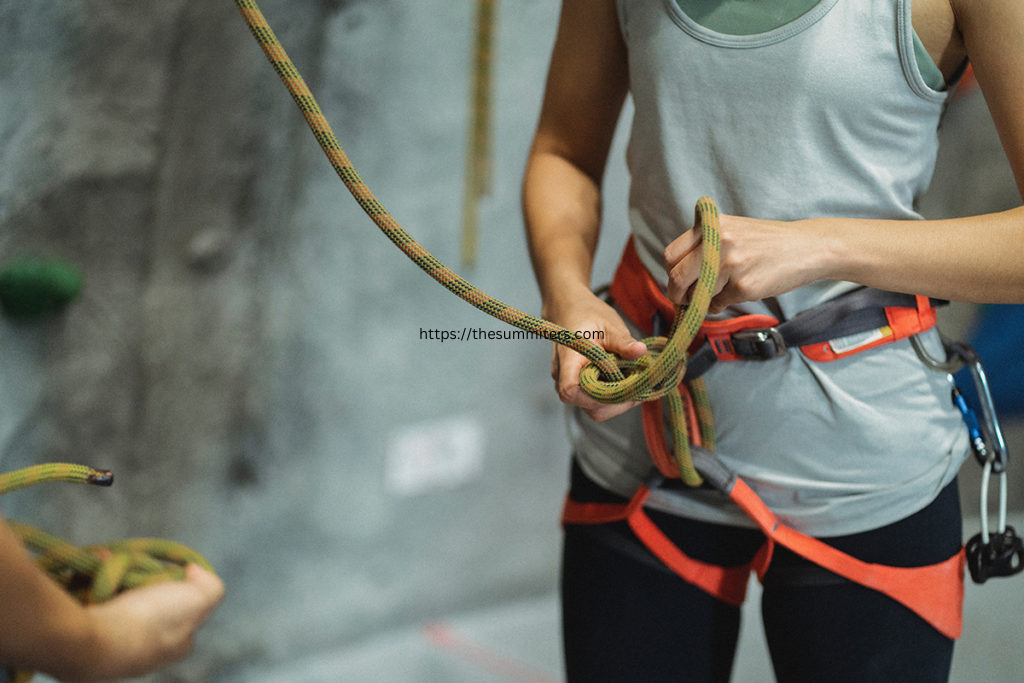
Ropes
Climbing ropes keep climbers safe if they fall and anchor them to the belay system. Dynamic ropes are stretchy, so they soften the impact on the climber and the anchor when there’s tension. Static ropes are for setting up anchors and pulling gear.
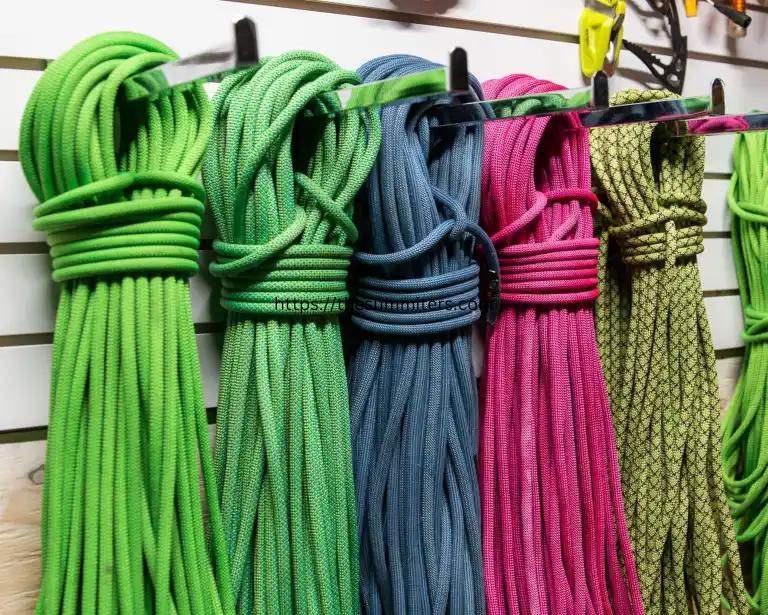
Belay Device
A belay device helps the person holding the rope (the belayer) to control it when they’re helping the climber come down, lowering them, or rappelling. It creates friction on the rope, which slows down or stops it from moving too fast. This way, the belayer can safely manage how the climber comes down. There are different kinds of belay devices, like tubular ones, assisted-braking ones, and figure-eight ones.
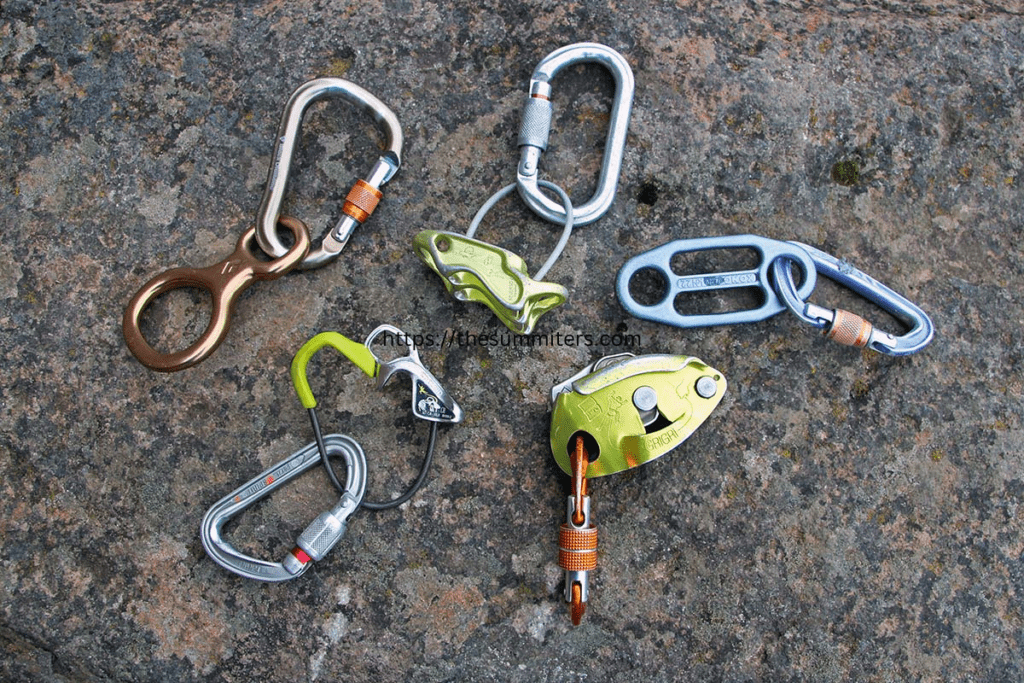
Helmet
A climbing helmet is really important for keeping the climber’s head safe from stuff like falling ice and rocks. They’re light, have holes for air, and can take more than one hit if something falls on them. They usually have straps and soft padding inside to fit well and feel comfy.
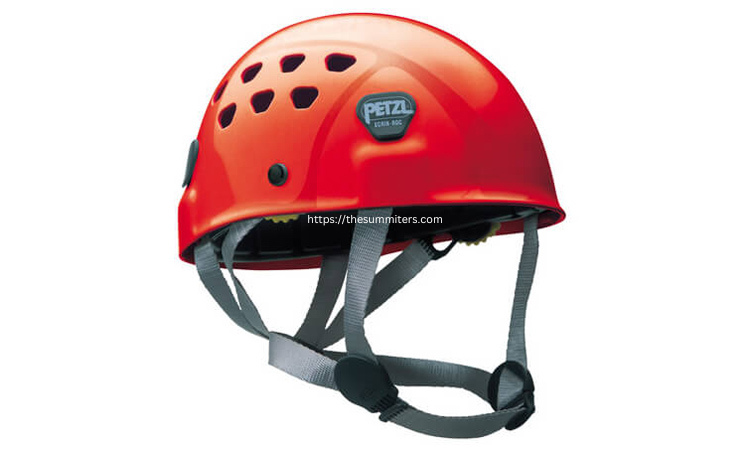
B. Specialized Equipment for Alpine Environments
In addition to essential gears, ice climbers may require specific equipment to navigate the unique challenges of alpine environments.
Some of these items include:
Ice Screws
These are like small metal rods with threads that climbers use to inclined themselves to the ice. You tighten them into the ice using a tool and they help keep you safe while ice climbing. Ice screws come in different size, it depends on how thick and strong the ice is.
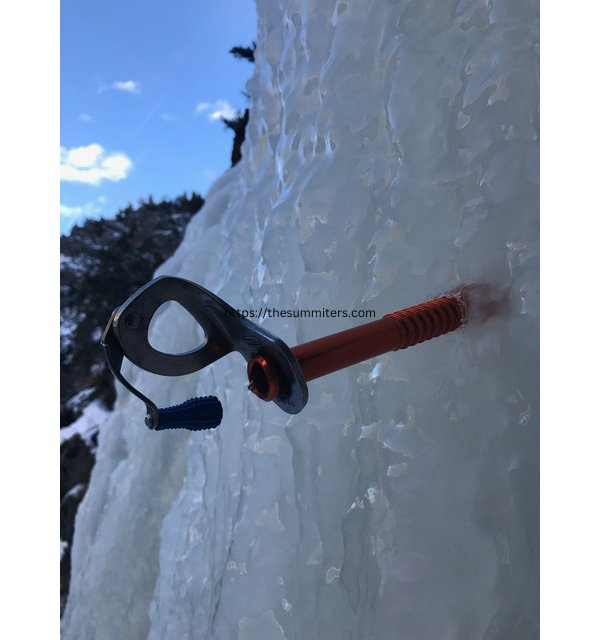
Snow Pickets
Snow pickets are long, tubular metal stakes used to anchor the climber to snow or ice. They are driven into the snow at an angle and attached to the climbing rope using a carabiner. Snow pickets are lightweight and versatile, making them ideal for building anchors in alpine terrain.
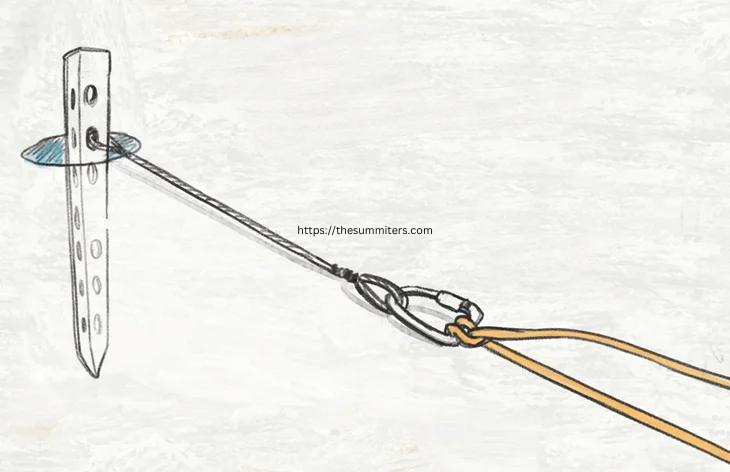
Ice Pitons
They are basically metal spikes that you hammer into the ice to give you extra safety. They’re handy for making spots to attach your rope when you’re coming down, setting up places to stop, or adding more protection in ice that’s not very thick or might break easily. Ice pitons come in different types, like ones shaped like knives, ones at an angle, and ones that are like tubes.

Alpine Climbing Pack
An alpine climbing pack is a simple, light backpack made for carrying important stuff when climbing in the mountains. It is built to be tough with spots to attach ice axes, crampons, and other gear. These packs usually hold around 20 to 40 liters enough space for what you need without being too big and heavy.
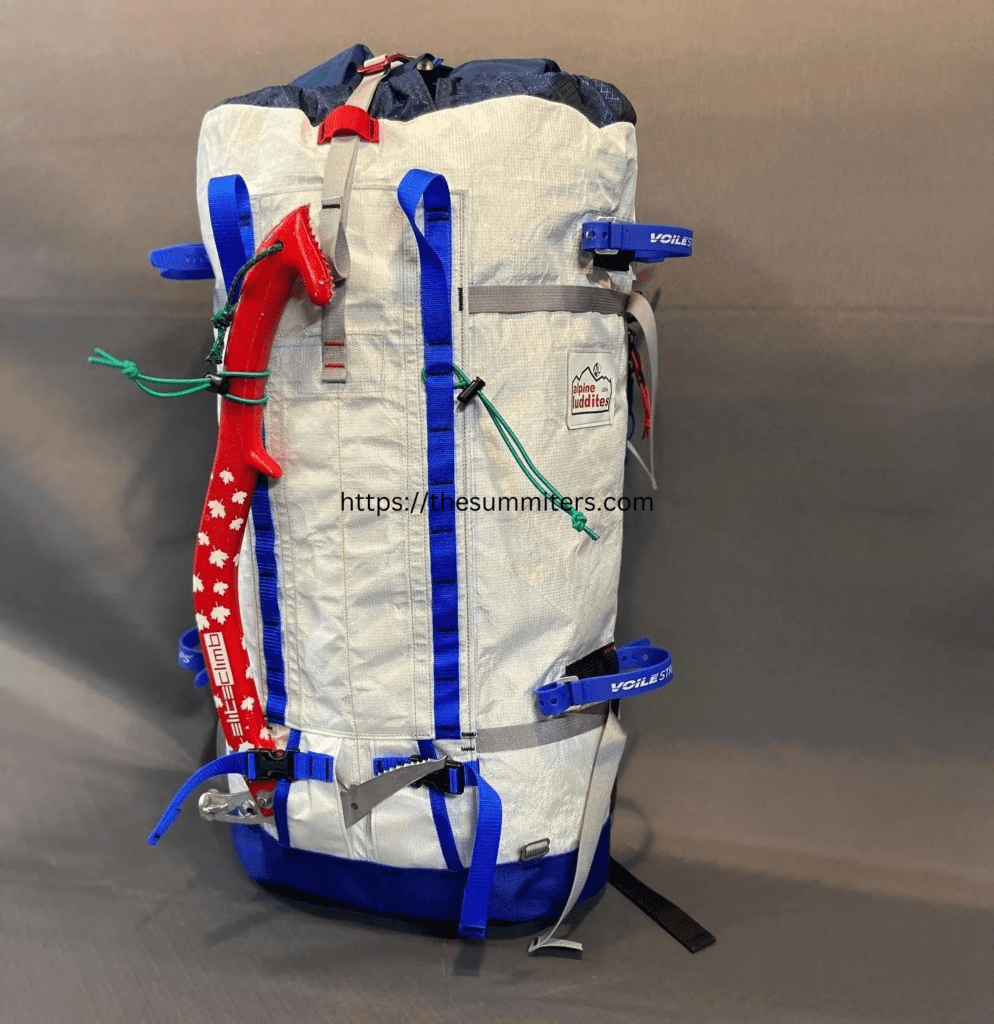
C. Safety Gear and Its Importance
Safety gear is essential for relieving risks and preventing accidents while ice climbing.
Here are some key safety items and their importance:
Helmet
Wearing a helmet is absolutely vital for keeping the climber safe from possible hazards like falling ice or rocks. It serves as the primary gadget of safety equipment and must be worn consistently throughout ice climbing expeditions to ensure protection against head injuries.
Harness and Rope
A harness and rope are really important for keeping the climber inclined to the safety system and preventing them from getting injured if they fall. They’re like a lifeline for both the climber and the person helping them, making sure they can go up and come down safely.
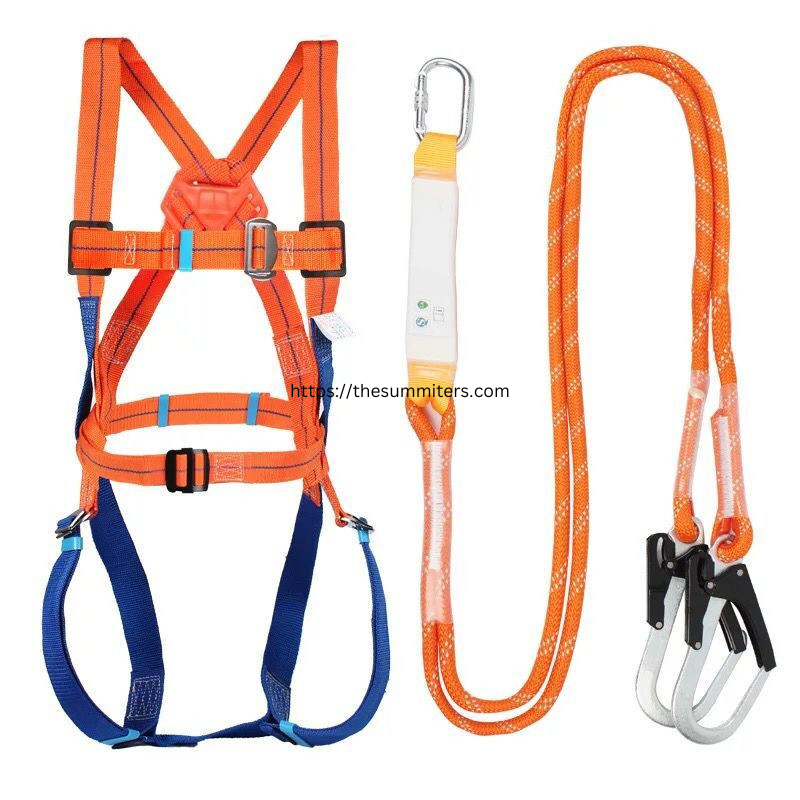
Belay Device and Anchors
A belay device and anchors are important tools for ice climbing. The belay device is that the person controlling the rope (the belayer) uses to control its movement ensuring the climber’s safety during ascend or descend. Anchors are points of attachment secured to the ice, providing a stable connection for the rope and adding an extra layer of safety. These tools offer diffusion, meaning there’s a backup plan in case of gear failure or sudden events, ensuring climbers are well protected during their ice climbing adventures.
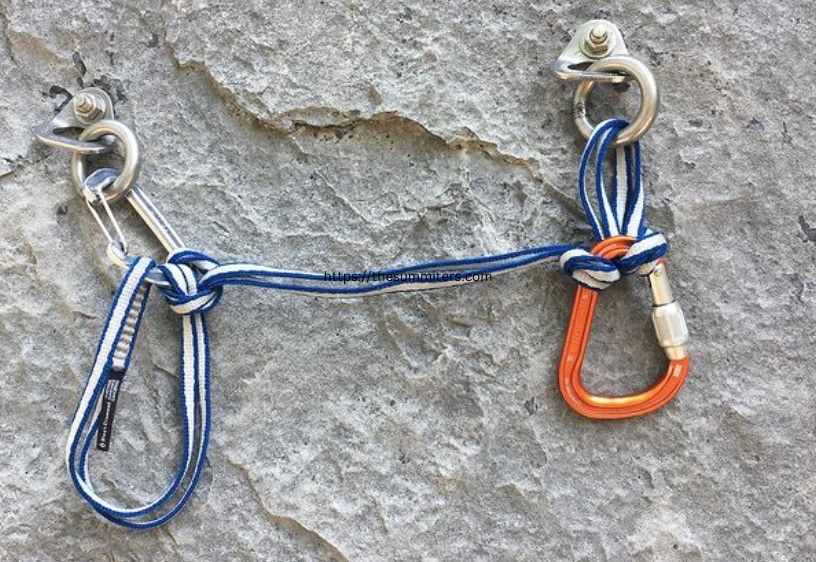
Communication Devices
Having communication gadgets like walkie talkies or satellite phones is really important for keeping in contact with climbing partners and getting help if something goes wrong. They let you talk to each other even in those places where regular phone signals don’t work.
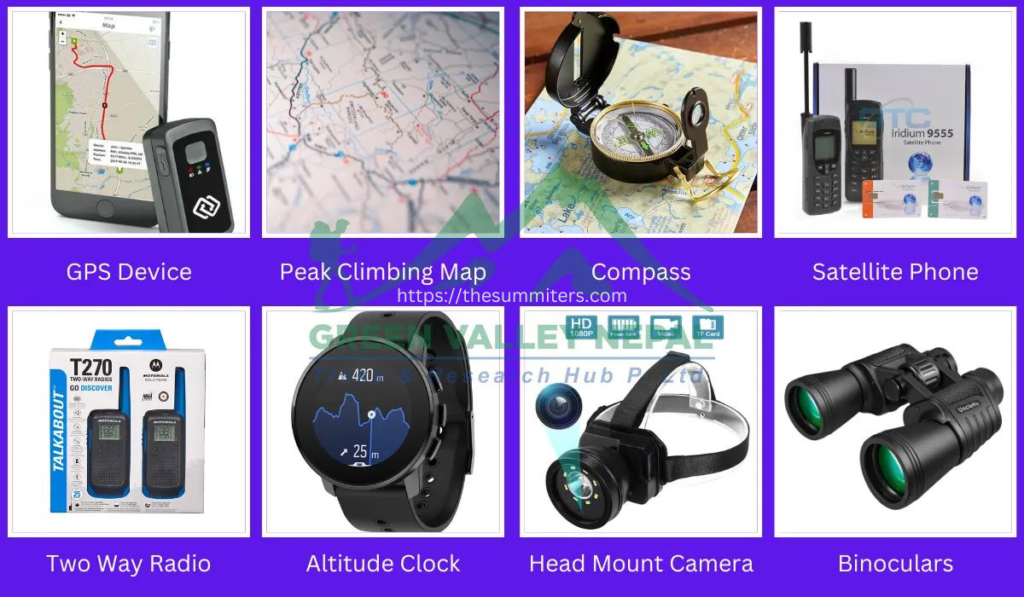
First Aid Kit
A first aid kit contains essential supplies for treating injuries and medical emergencies in the field. It should include items such as bandages gauze pads, adhesive tape, antiseptic wipes, and pain relievers. A well stocked first aid kit can make all the difference in a medical emergency.
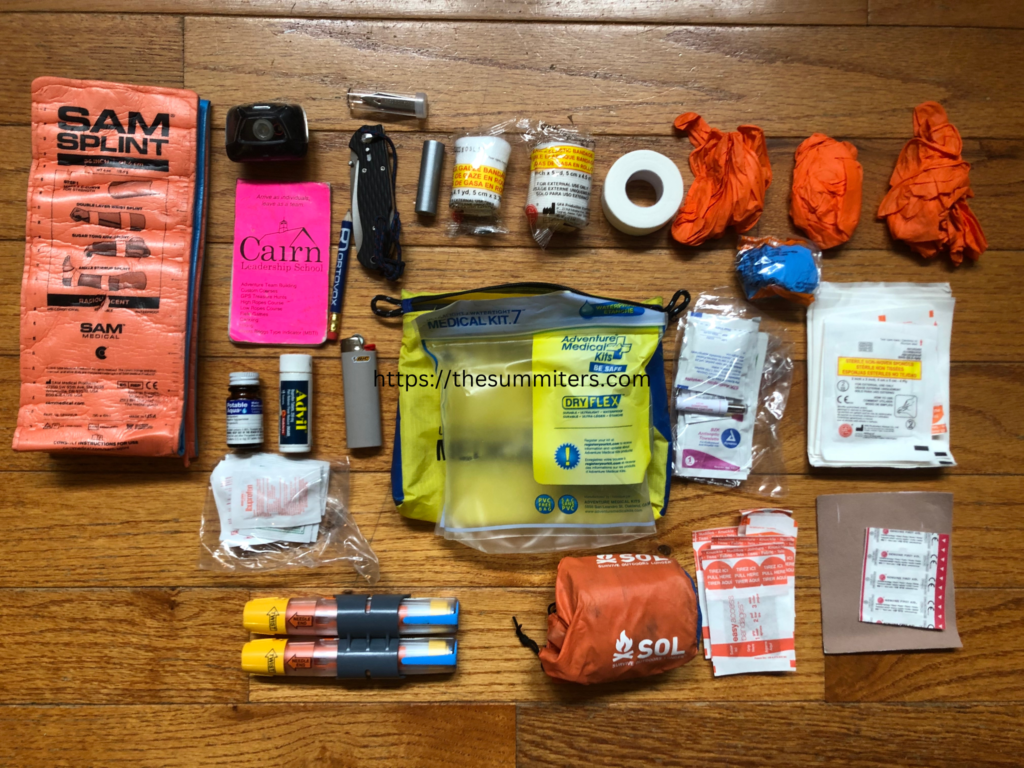
In conclusion, ensuring you have the right tools, equipment, and safety gear is paramount for a safe and enjoyable ice climbing expedition in alpine environments. It’s essential for climbers to invest in high-quality gear, undergo proper training, and adhere to safety protocols to minimize risks and enhance their overall experience on the ice.
IV. Techniques and Strategies for Alpine Ice Hacking
A. Ice Climbing Basics
Ice climbing basics encompass a range of fundamental techniques and skills that form the foundation of safe and efficient climbing on ice.
Here are some essential techniques for beginners:
Swinging Ice Axes
Ice axes are the primary tools for ice climbing, used to grip the ice and provide stability while ascending. Beginners should practice swinging ice axes to develop accuracy, power, and control. Proper technique involves using the wrist to generate force and aiming for solid placements in the ice.
Kicking Crampons
Crampons are metal spikes attached to the climber’s boots, providing traction on ice and hard-packed snow. Beginners should practice kicking their crampons into the ice to create secure footholds. Proper technique involves using the front points of the crampons to penetrate the ice and maintain balance while climbing.
Body Positioning
Proper body positioning is essential for efficient and effective ice climbing. Climbers should maintain a balanced and stable stance, with their weight centered over their feet and their body close to the ice. This helps conserve energy and reduces the risk of slipping or falling.
Using the Feet
While ice climbing, climbers should rely on their feet as much as possible to support their weight and propel themselves upward. This involves using the front points of the crampons to grip the ice and the edges of the boots to edge on steep terrain.
Resting and Relaxing
Ice climbing can be physically demanding, so it’s essential to take breaks and rest when needed. Climbers should look for opportunities to shake out their arms, shift their weight, and relax their grip on the ice axes to conserve energy and prevent fatigue.
B. Advanced Techniques for Challenging Ice Conditions
As climbers progress in their skills and confidence, they can begin to tackle more challenging ice conditions using advanced techniques.
Here are some techniques used by experienced climbers:
Steep Ice Climbing
Steep ice climbing involves ascending vertical or overhanging ice walls using specialized techniques and equipment. Climbers must use powerful swings of the ice axes and precise placements of the crampons to navigate steep terrain safely.
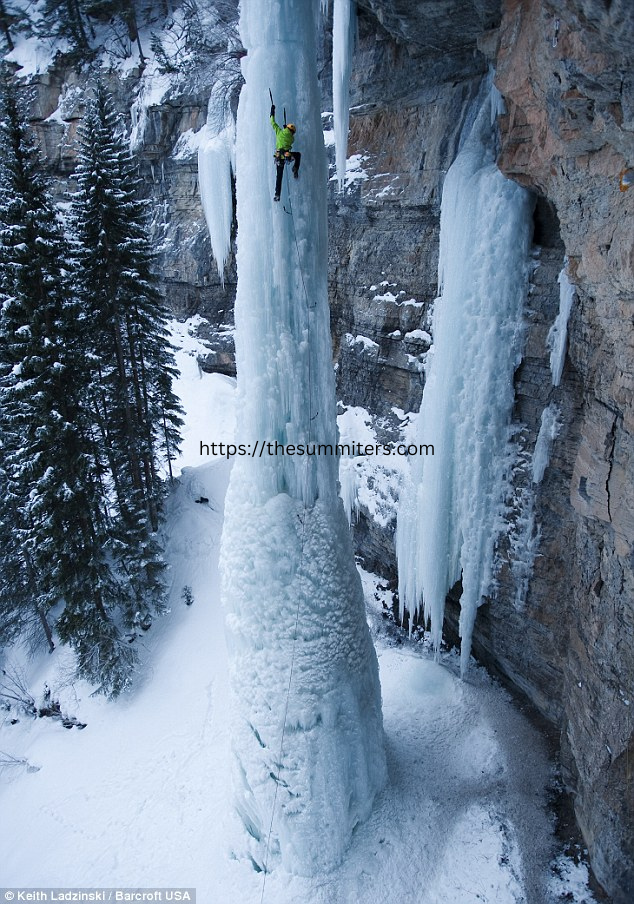
Dry Tooling
Dry tooling is a technique used to climb rock using ice tools and crampons. It requires precise footwork and delicate balance to ascend rock faces with minimal ice or snow cover. Dry tooling is often practiced on mixed routes that feature a combination of rock and ice.
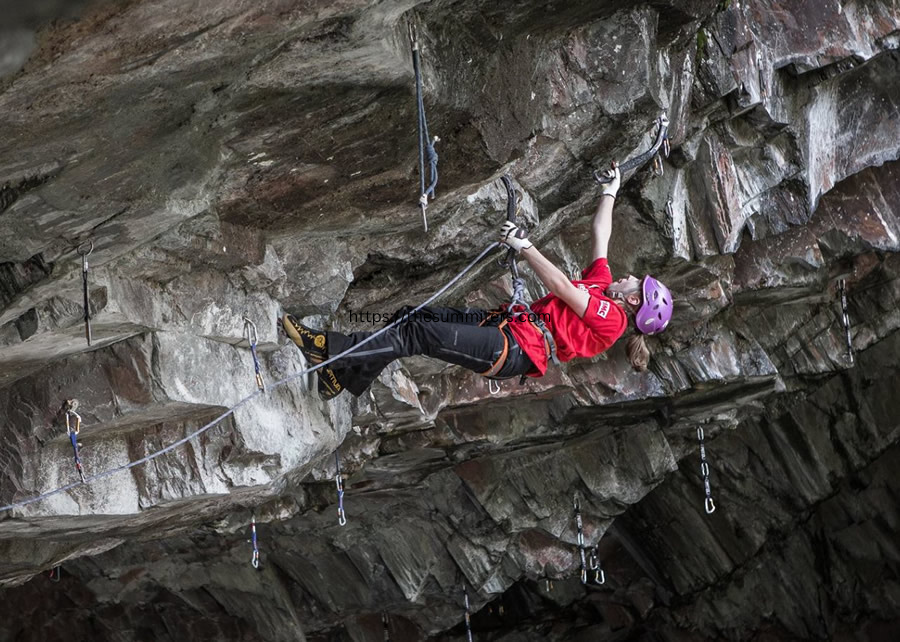
Tool Placement
Advanced climbers develop a keen sense of ice quality and learn to place their ice tools in the most secure and efficient positions. This involves assessing the density and stability of the ice and choosing placements that offer the best grip and support.
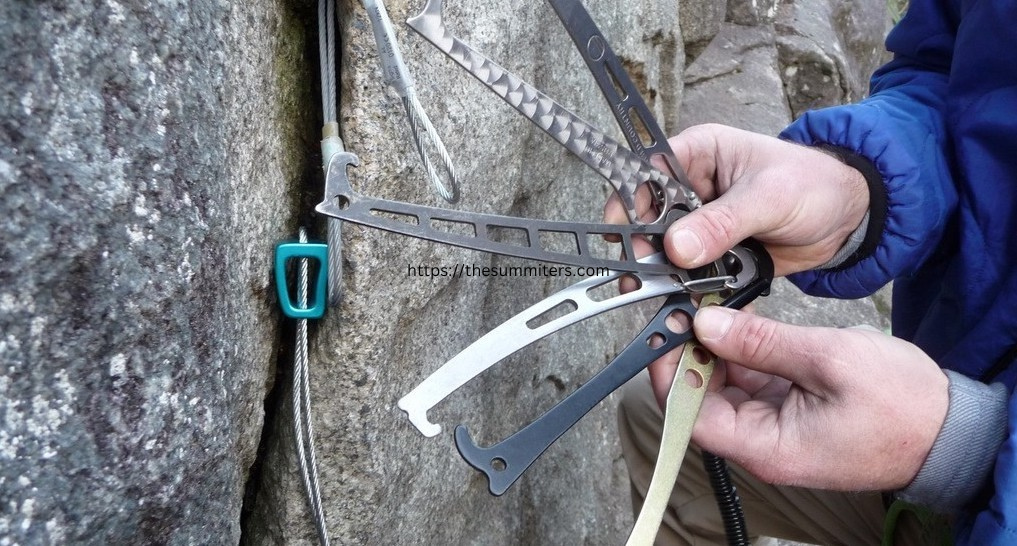
Screw Placement
Ice screws are like anchors that climbers tighten into the ice to keep safe them from falling. Skilled climbers learn how to put them in speed and strong, using methods like screwing them in and clipping onto them, or even putting them in without using their other hand.
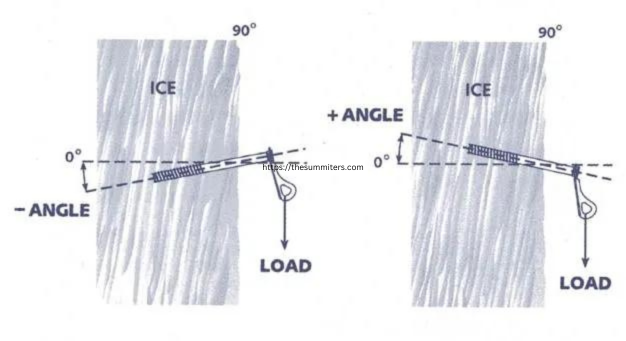
Tool Switching
Tool switching is a technique used to transition between ice axes while climbing. It allows climbers to maintain a steady pace and conserve energy by alternating the use of their dominant and non dominant hands.
C. Strategies for Efficient Progression
Efficient progression is essential for maintaining momentum and conserving energy during an ice climb.
Here are some strategies for climbing efficiently:
Route Planning
Before beginning a climb, climbers should take their time to look closely at the route and spot important things like places to take breaks, spots where the ice naturally forms, and where they can put safety gear. This helps climbers prepare for challenges and figure out their plan for climbing.
Pacing
Climbers should keep a steady speed while they climb, finding the right balance between going fast and using energy wisely to avoid getting too tired. Pacing means finding a comfortable rhythm that lets you keep moving without getting worn out too soon.
Resting Strategically
Climbers should make the most of chances to rest by giving their arms a break, taking deep breaths, and drinking water. Taking breaks at the right times during the climb can help keep up energy levels and avoid getting too tired.
Communication and Collaboration
Climbing with a team lets climbers divide up the work and help each other as they climb. It’s really important to talk to each other and work together well to coordinate moves, share equipment, and solve any problems that come up.
Reading the Ice
Experienced climbers get really good at spotting things like cracks, bumps, and weak spots in the ice. This helps them predict when the ice might change and tweak their climbing style to match.
When ice climbers learn the fundamentals, practice harder skills, and use smart ways to get better, they can confidently climb difficult routes. This helps them have more fun and be more successful on the ice.
V. Safety Measures and Risk Management
Ice climbing in alpine environments presents inherent risks and challenges that require careful consideration and proactive measures to mitigate. Understanding and implementing effective safety measures and risk management strategies are essential for ensuring a safe and enjoyable ice climbing experience. Here’s a deep look at each aspect:
A. Risk Assessment in Alpine Ice Climbing
Terrain Evaluation: Before starting a climb, it’s crucial to assess the terrain and identify potential hazards such as avalanche-prone slopes, seracs, crevasses, and rockfall zones. Understanding the layout of the terrain helps climbers make informed decisions about route selection and safety precautions.
Weather Forecasting: Monitoring weather conditions is essential for ice climbers, as weather can change rapidly in alpine environments. Climbers should check weather forecasts before and during the climb, paying attention to factors such as temperature, wind speed, precipitation, and avalanche danger ratings.
Ice Conditions
Evaluating ice conditions is critical for determining the stability and quality of the climbing surface. Climbers should assess factors such as ice thickness, density, and adherence to the underlying rock or snow. Testing ice with a tool or ice screw can provide valuable information about its strength and integrity.
Group Dynamics:
Assessing the experience level, fitness, and capabilities of climbing partners is essential for ensuring a safe and successful climb. Climbers should communicate openly and honestly about their skills and limitations and work together to establish realistic goals and objectives for the climb.
Route Hazards:
Identifying potential hazards along the route, such as loose rock, unstable ice, or overhanging cornices, allows climbers to take appropriate precautions and avoid unnecessary risks. Climbers should scout the route beforehand, if possible, and be prepared to adapt their plans based on changing conditions.
B. Safety Protocols and Precautions
- Use of Safety Equipment
Climbers should always wear appropriate safety gear, including helmets, harnesses, and crampons, and ensure that all equipment is properly fitted and in good condition. Regular inspection and maintenance of gear are essential for preventing equipment failure and accidents.
- Belaying and Anchoring:
Proper belaying and anchoring techniques are essential for protecting climbers in the event of a fall. Climbers should use redundant anchor systems, such as the equalized anchor or the quad anchor, and employ appropriate belay devices to minimize the risk of accidents.
- Communication and Signals:
Effective communication between climbing partners is crucial for coordinating movements, sharing information, and responding to emergencies. Climbers should establish clear communication protocols and signals before beginning the climb and use them consistently throughout the ascent and descent.
- Risk Minimization Strategies:
Climbers should adopt strategies to minimize risk and maximize safety while climbing. This includes techniques such as placing protection frequently, avoiding climbing directly beneath other parties, and maintaining a safe distance from potential hazards such as rockfall or avalanches.
- Emergency Response Plan:
Climbers should develop an emergency response plan that outlines procedures for responding to accidents, injuries, or other emergencies. This plan should include protocols for assessing the situation, administering first aid, summoning outside assistance, and executing a rescue if necessary.
C. Emergency Preparedness and Rescue Procedures
First Aid Training: All climbers should receive basic first aid training and be prepared to administer first aid in the event of an accident or injury. This includes skills such as treating wounds, immobilizing fractures, managing hypothermia, and performing CPR.
- Communication Devices:
Carrying communication devices such as two-way radios, satellite phones, or personal locator beacons (PLBs) can facilitate communication with rescue services and expedite the response in an emergency. Climbers should ensure that communication devices are fully charged and accessible at all times.
- Self-Rescue Skills:
Climbers should develop self-rescue skills to handle common emergencies such as rope entanglement, stuck rappel ropes, or stranded climbers. This includes techniques such as ascending ropes, escaping belay systems, and improvising anchors.
- Emergency Shelter and Survival Gear:
Carrying emergency shelter and survival gear, such as a bivouac sack, space blanket, or emergency stove, can provide essential protection and comfort in case of an unexpected bivouac or prolonged rescue operation.
- Coordination with Rescue Services:
In the event of a serious accident or emergency, climbers should contact local rescue services or emergency responders as soon as possible and provide detailed information about the location, nature of the incident, and condition of the injured party. Maintaining clear communication and cooperation with rescue services is essential for a successful rescue operation.
By implementing effective safety measures, conducting thorough risk assessments, and being prepared for emergencies, ice climbers can minimize risks and enjoy a safe and rewarding experience in alpine environments.
VI. Environmental Considerations
Ice climbing in alpine environments not only offers exhilarating challenges but also presents climbers with the responsibility to preserve the fragile ecosystems they explore. Environmental considerations are paramount to ensuring that future generations can continue to enjoy the pristine beauty of these remote landscapes. Here’s an in-depth exploration of the environmental aspects of alpine ice climbing:
A. Leave No Trace Principles
Leave No Trace (LNT) principles are a set of guidelines designed to minimize human impact on the environment while enjoying outdoor activities. These principles are particularly relevant in alpine environments, where ecosystems are delicate and vulnerable to disturbance.
Here are the seven Leave No Trace principles and their application to ice climbing:
- Plan Ahead and Prepare
Before embarking on an ice climbing trip, climbers should research the area’s regulations, weather conditions, and environmental considerations. They should pack appropriately, including carrying out all waste and adhering to any permit requirements.
- Travel and Camp on Durable Surfaces:
When traveling through alpine environments, climbers should stick to established trails and routes to minimize trampling on fragile vegetation and soil. When camping, climbers should choose durable surfaces such as rock or snow and avoid setting up camp in sensitive areas such as meadows or near water sources.
- Dispose of Waste Properly
Ice climbers should pack out all waste, including human waste, food scraps, and trash. Waste disposal in alpine environments can be challenging due to the lack of facilities, so climbers should carry out all waste and dispose of it properly upon returning to civilization.
- Leave What You Find:
Climbers should leave natural features, plants, and artifacts undisturbed to preserve the integrity of the environment. This includes refraining from removing rocks, plants, or other natural materials and avoiding damaging cultural or historical sites.
- Minimize Campfire Impacts:
Campfires are generally discouraged in alpine environments due to the scarcity of firewood and the risk of starting wildfires. If a campfire is necessary, climbers should use existing fire rings or designated fire pits and only burn dead and downed wood.
- Respect Wildlife
Alpine environments are home to a diverse range of wildlife species, including endangered and sensitive populations. Climbers should observe wildlife from a distance, refrain from feeding or approaching animals, and avoid disturbing nesting or breeding areas.
- Be Considerate of Other Visitors:
Ice climbers should be respectful of other outdoor enthusiasts, including hikers, skiers, and snowshoers. This includes yielding the right of way on trails, keeping noise levels to a minimum, and practicing good trail etiquette.
B. Minimizing Environmental Impact
In addition to following Leave No Trace principles, ice climbers can take proactive measures to minimize their environmental impact while climbing in alpine environments.
Here are some additional strategies for minimizing environmental impact:
- Stay on Designated Routes
Climbers should stick to established climbing routes and avoid creating new trails or damaging vegetation. This helps prevent soil erosion and preserves the natural beauty of the landscape.
- Avoid Disturbing Wildlife
Climbers should be mindful of wildlife habitat and avoid disturbing nesting birds or other sensitive wildlife species. This may involve avoiding climbing routes near known nesting sites or taking precautions to minimize noise and disturbance.
- Practice Low-Impact Anchoring
When building anchors or belay stations, climbers should use techniques that minimize damage to the rock or ice surface. This may include using ice screws or removable bolts instead of pitons or other fixed anchors.
- Clean Climbing Practices
Climbers should practice “clean climbing” techniques that minimize damage to the rock or ice surface. This includes avoiding unnecessary tool placements, minimizing the use of chalk, and cleaning up any trash or debris left behind.
- Leave Minimal Trace of Passage
Climbers should strive to leave minimal trace of their passage through the landscape. This may involve brushing away chalk marks, filling in bootprints, and removing any gear or equipment left behind.
C. Sustainable Practices for Alpine Ice Climbing
Sustainable practices for alpine ice climbing focus on minimizing environmental impact while promoting the long-term health and integrity of the natural environment.
Here are some sustainable practices for ice climbing in alpine environments:
- Educational Outreach
Ice climbers can promote environmental awareness and stewardship by educating themselves and others about the importance of preserving alpine ecosystems. This may involve participating in Leave No Trace workshops, volunteering for trail maintenance projects, or advocating for conservation initiatives.
- Supporting Conservation Organizations
Climbers can support conservation organizations and initiatives that work to protect alpine environments and promote sustainable recreation practices. This may include donating money or time to environmental organizations, participating in clean-up efforts, or advocating for land protection measures.
- Responsible Access and Permitting
Climbers should respect access restrictions and permitting requirements in alpine environments to minimize overcrowding and resource degradation. This may involve obtaining permits for backcountry access, respecting seasonal closures, and adhering to group size limits.
- Advocating for Responsible Recreation Policies
Ice climbers can advocate for responsible recreation policies and regulations that promote sustainable use of alpine environments. This may involve participating in public comment periods, contacting elected officials, or joining advocacy groups that work on conservation issues.
- Leading by Example
Ultimately, sustainable ice climbing practices begin with individual climbers taking responsibility for their actions and leading by example. By demonstrating a commitment to environmental stewardship and promoting sustainable practices within the climbing community, climbers can help preserve the beauty and integrity of alpine environments for future generations to enjoy.
By incorporating Leave No Trace principles, minimizing environmental impact, and adopting sustainable practices, ice climbers can enjoy the thrill of alpine ice climbing while preserving the natural beauty and ecological integrity of these pristine landscapes.
VII. Training and Preparation
Alpine ice climbing demands a combination of physical strength, mental focus, and technical skill. Training and preparation are essential aspects of ensuring climbers are adequately equipped to tackle the challenges of ice climbing in alpine environments.
Here’s an in-depth exploration of the training and preparation necessary for success in alpine ice climbing:
A. Physical Conditioning for Alpine Ice Climbing
Strength Training: Ice climbing requires significant upper body and core strength to pull oneself up the ice and maintain balance on steep terrain. Climbers should focus on exercises that target the muscles used in ice climbing, including the forearms, biceps, shoulders, and core. This may include pull-ups, dead hangs, rows, and planks.
- Endurance Training
Ice climbing is a physically demanding activity that requires sustained effort over long periods. Climbers should incorporate cardiovascular exercises such as running, cycling, or hiking into their training routine to build endurance and stamina. High-intensity interval training (HIIT) can also be beneficial for improving anaerobic capacity and recovery times.
- Flexibility and Mobility
Flexibility and mobility are crucial for maneuvering on ice and maintaining proper body position. Climbers should incorporate stretching exercises into their routine to improve flexibility in the hips, shoulders, and lower back. Yoga and mobility drills can help increase range of motion and reduce the risk of injury.
- Balance and Coordination
Ice climbing requires precise footwork and balance to navigate steep terrain and maintain stability on the ice. Climbers can improve balance and coordination through activities such as slacklining, rock climbing, and balance board exercises. Practicing on uneven or unstable surfaces can help develop proprioception and spatial awareness.
- Specific Training Exercises
Climbers can supplement their general strength and conditioning routine with specific exercises tailored to ice climbing. This may include simulated ice climbing workouts using hangboards, campus boards, or dry tooling routes. These exercises help develop grip strength, technique, and mental toughness specific to ice climbing.
B. Mental Preparation and Focus
Visualization and Mental Imagery: Mental preparation is just as important as physical conditioning in ice climbing. Climbers should visualize themselves successfully completing climbs, visualizing each move and sequence in detail. Mental imagery can help build confidence, reduce anxiety, and improve focus during climbs.
- Positive Self-Talk
Maintaining a positive mindset is crucial for overcoming challenges and setbacks in ice climbing. Climbers should practice positive self-talk, using affirmations and mantras to reinforce confidence and self-belief. Positive self-talk can help combat negative thoughts and doubts, allowing climbers to stay focused and motivated.
- Goal Setting
Setting specific, achievable goals is essential for staying motivated and focused during training and climbs. Climbers should set both short-term and long-term goals, breaking them down into smaller, manageable milestones. This helps create a sense of progress and accomplishment, driving motivation and commitment.
- Stress Management
Ice climbing can be mentally demanding, particularly in high-pressure situations or challenging conditions. Climbers should develop stress management techniques such as deep breathing, mindfulness meditation, or progressive muscle relaxation. These techniques help reduce anxiety and improve concentration and decision-making under pressure.
- Focus and Concentration
Maintaining focus and concentration is critical for success in ice climbing, where split-second decisions can have significant consequences. Climbers should practice mindfulness techniques to stay present and focused during climbs, tuning out distractions and maintaining awareness of their surroundings.
C. Skill Development and Training Programs
- Technical Skills Training
Ice climbing requires mastery of a range of technical skills, including ice axe placement, crampon technique, and rope management. Climbers should seek out opportunities for technical skills training, either through guided instruction, mentorship from experienced climbers, or self-directed practice sessions.
- Guided Climbing Trips
Guided climbing trips provide an opportunity for climbers to learn from experienced guides and instructors while gaining practical experience in alpine environments. These trips often include instruction in climbing techniques, safety protocols, and route finding, tailored to the skill level and objectives of the participants.
- Climbing Courses and Workshops
Climbing courses and workshops offer structured training programs designed to develop specific skills and competencies in ice climbing. These courses may cover topics such as ice climbing fundamentals, advanced techniques, lead climbing, anchor building, and rescue skills. Climbers can choose courses that align with their goals and interests, ranging from introductory classes for beginners to advanced clinics for experienced climbers.
- Practice and Repetition
Like any skill, ice climbing requires practice and repetition to develop proficiency and confidence. Climbers should seek out opportunities to climb regularly, whether indoors at a climbing gym or outdoors on natural ice formations. Practicing on a variety of routes and conditions helps climbers build adaptability and problem-solving skills.
- Progression and Gradual Advancement
Climbers should approach skill development and training in a progressive and gradual manner, building on foundational skills and gradually increasing difficulty and complexity. This allows climbers to develop a solid technical foundation while minimizing the risk of injury or burnout. Climbers should listen to their bodies and avoid pushing
VIII. Notable Alpine Ice Climbing Destinations
A. Description of Iconic Alpine Routes
Mont Blanc Massif, France/Italy: The Mont Blanc Massif offers some of the most iconic and challenging ice climbing routes in the Alps. The Cosmiques Ridge, located on the Aiguille du Midi, is a classic alpine route renowned for its stunning views and technical climbing. Other notable routes include the North Face of the Grandes Jorasses and the Frendo Spur on the Aiguille du Midi.
Eiger, Switzerland
The Eiger’s north face is legendary in the world of alpine climbing, with classic routes such as the Heckmair Route and the Direct Route. Climbing the Eiger’s north face requires advanced technical skills and a high level of fitness, as well as a strong understanding of avalanche risk and objective hazards.
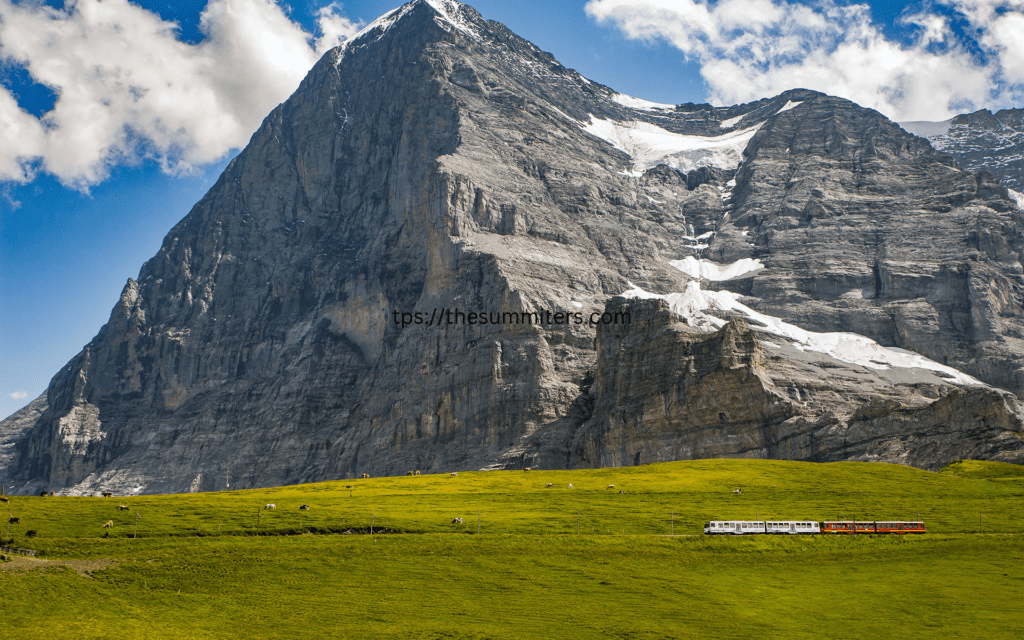
Matterhorn, Switzerland/Italy
The Matterhorn‘s iconic pyramidal peak offers a variety of challenging ice climbing routes, including the Lion Ridge and the Zmutt Ridge. Climbing the Matterhorn requires a combination of technical ice climbing skills, rock climbing ability, and alpine experience.
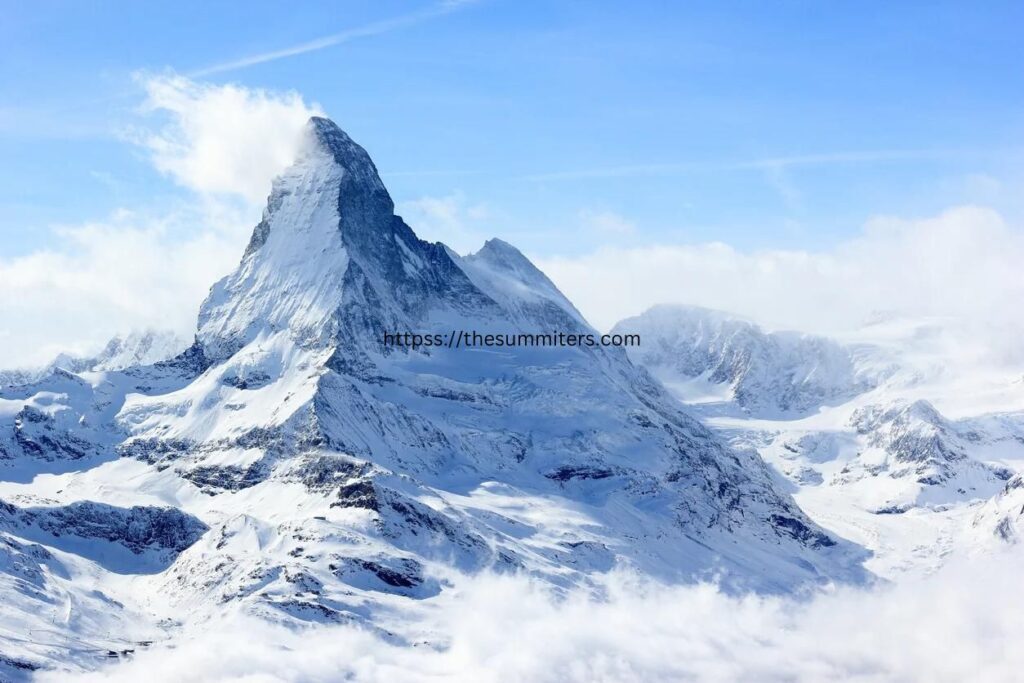
Dolomites, Italy
The Dolomites are known for their dramatic limestone spires and challenging ice climbing routes. Classic routes include the Messner Route on the Tre Cime di Lavaredo, the Vinatzer Route on the Marmolada, and the Comici Route on the Cima Grande. Climbers can expect steep, technical climbing and stunning alpine scenery.
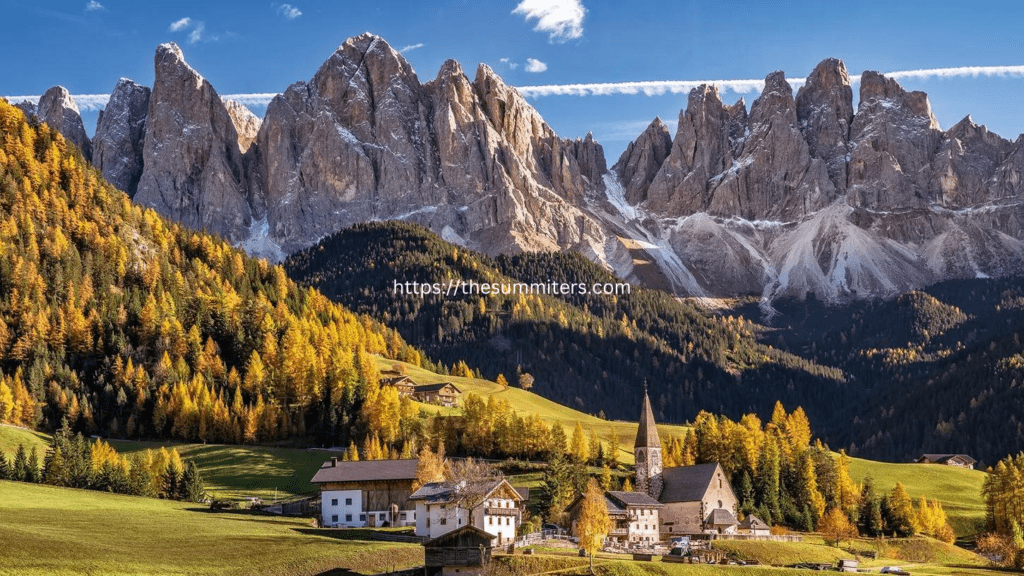
Chamonix, France
Chamonix is a mecca for ice climbers, with a wide range of classic routes and challenging alpine terrain. The Gervasutti Couloir on the Tacul Triangle, the Whymper Couloir on the Aiguille Verte, and the Couturier Couloir on the Aiguille du Midi are just a few of the iconic routes in the area.
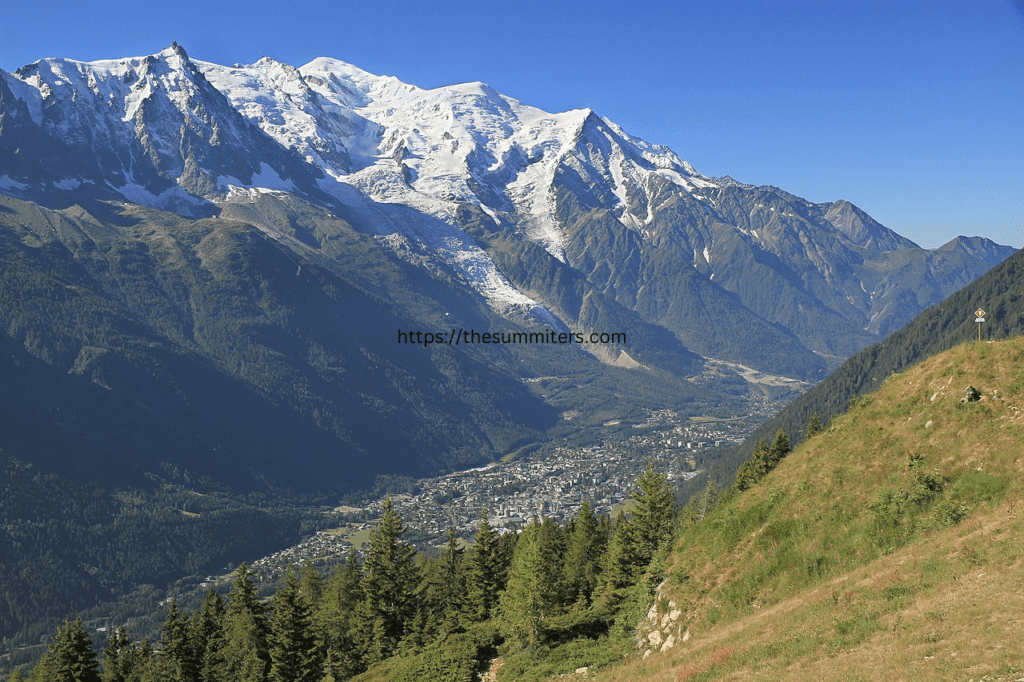
B. Tips for Planning an Ice Climbing Trip
Research Climbing Conditions: Before planning an ice climbing trip, research current climbing conditions, weather forecasts, and route conditions for your chosen destination. This will help you determine the best time to visit and ensure optimal climbing conditions.
- Assess Your Skills and Experience
Be honest with yourself about your climbing abilities and experience level. Choose routes that are appropriate for your skill level and avoid attempting routes that are beyond your capabilities.
- Gather Necessary Gear
Make sure you have all the necessary gear for ice climbing, including ice axes, crampons, ropes, harnesses, helmets, and protective clothing. Check that your gear is in good condition and suitable for the terrain and conditions you’ll encounter.
- Plan for Safety
Safety should always be a top priority when ice climbing. Make sure you have a solid understanding of avalanche risk, objective hazards, and emergency procedures for your chosen destination. Carry a first aid kit, communication devices, and navigation tools, and know how to use them effectively.
- Consider Hiring a Guide
If you’re new to ice climbing or unfamiliar with the area, consider hiring a certified guide or joining a guided climbing trip. Guides can provide valuable instruction, local knowledge, and logistical support, enhancing safety and enjoyment on the climb.
C. Safety Guidelines for Specific Locations
- Mont Blanc Massif
When climbing in the Mont Blanc Massif, be prepared for rapidly changing weather conditions, high altitudes, and technical terrain. Check avalanche forecasts and route conditions regularly, and be aware of objective hazards such as seracs and crevasses. Stay on established routes and use caution when navigating steep terrain.
- Eiger North Face
Climbing the Eiger’s north face requires advanced technical skills and alpine experience. Be prepared for extreme weather, rockfall, and objective hazards such as avalanches and falling ice. Use caution when crossing snowfields and navigating exposed ridges, and be prepared to retreat if conditions deteriorate.
- Matterhorn
Climbing the Matterhorn is a serious undertaking that requires careful planning and preparation. Be aware of objective hazards such as rockfall and icefall, and use caution when navigating steep terrain and exposed ridges. Check route conditions and weather forecasts regularly, and be prepared to turn back if conditions are unfavorable.
- Dolomites
The Dolomites offer a wide range of ice climbing routes suitable for climbers of all skill levels. Be prepared for steep, technical climbing and variable conditions, and use caution when climbing on limestone rock. Check route conditions and weather forecasts before heading out, and be aware of potential hazards such as loose rock and changing ice conditions.
- Chamonix
Chamonix is a popular destination for ice climbers, with a variety of classic routes and challenging terrain. Be prepared for high-altitude climbing, extreme weather, and objective hazards such as avalanches and rockfall. Check route conditions and avalanche forecasts regularly, and be prepared to adjust your plans accordingly.
By following these tips and safety guidelines, you can plan a successful and enjoyable ice climbing trip to some of the most iconic alpine destinations in the world. Remember to prioritize safety, respect the environment, and enjoy the adventure!
IX. Conclusion
A. Recap of Alpine Ice Hacking Essentials
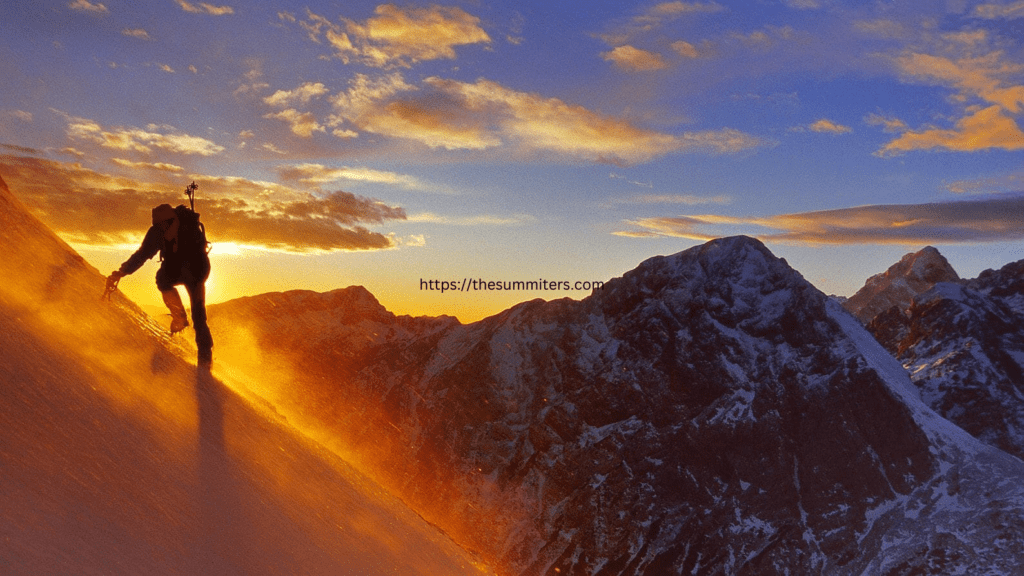
Alpine ice hacking, while exhilarating and challenging, demands careful preparation, skill, and respect for the environment. Throughout this guide, we’ve explored the essential aspects of alpine ice climbing, from understanding the characteristics of alpine environments to mastering the necessary skills and techniques. Here’s a recap of the key essentials:
- Understanding Alpine Environments
Recognizing the unique characteristics and challenges of alpine environments, including weather variability, terrain hazards, and technical difficulties.
- Tools and Equipment
Equipping oneself with the necessary gear for ice climbing, including ice axes, crampons, ropes, and safety equipment, and understanding their proper use and maintenance.
- Safety Measures and Risk Management
Implementing effective safety protocols, conducting risk assessments, and practicing emergency preparedness to minimize risks and ensure a safe climbing experience.
- Training and Preparation
Undertaking physical conditioning, mental preparation, and skill development to build strength, endurance, and confidence for ice climbing adventures.
- Notable Alpine Ice Climbing Destinations
Exploring iconic alpine routes and destinations, from the Mont Blanc Massif to the Matterhorn, and planning trips with safety and responsibility in mind.
B. Encouragement for Safe and Responsible Ice Climbing
As passionate climbers and outdoor enthusiasts, it’s essential to approach ice climbing with a mindset of respect, responsibility, and stewardship. Each ascent is an opportunity to connect with nature, challenge oneself, and build lasting memories. However, it’s crucial to prioritize safety at all times, both for oneself and for others sharing the mountain environment.
By adhering to Leave No Trace principles, minimizing environmental impact, and practicing sustainable climbing practices, we can help preserve the natural beauty and integrity of alpine environments for future generations. Moreover, fostering a culture of safety, education, and mentorship within the climbing community can empower climbers of all levels to pursue their passion while minimizing risks and promoting responsible recreation.
Remember, the mountains will always be there, waiting to be explored and conquered. By approaching ice climbing with humility, mindfulness, and a commitment to safety, we can continue to experience the magic of alpine ice hacking for years to come.
C. Looking Ahead: Future Trends in Alpine Ice Climbing
As ice climbing continues to evolve as a sport, we can anticipate several future trends and developments:
- Technological Advances
Continued innovation in gear and equipment, such as lighter and more durable ice axes, crampons, and protective clothing, will enhance climbers’ performance and comfort in alpine environments.
- Accessibility and Inclusivity
Efforts to make ice climbing more accessible and inclusive, including initiatives to increase diversity and representation within the climbing community, will broaden participation and foster a welcoming and supportive environment for all climbers.
- Environmental Conservation
Growing awareness of the importance of environmental conservation and sustainability will drive efforts to protect alpine ecosystems and minimize the impact of climbing activities on fragile mountain environments.
- Education and Training
Increased emphasis on education and training, including courses, workshops, and mentorship programs, will empower climbers to develop the skills, knowledge, and confidence necessary for safe and responsible ice climbing.
- Exploration and Adventure
As climbers seek new challenges and experiences, there will be a continued interest in exploring remote and uncharted ice climbing destinations, pushing the boundaries of what is possible in alpine ice hacking.
In conclusion, alpine ice climbing represents a unique blend of physical exertion, mental fortitude, and spiritual connection with nature. By embracing the principles of safety, responsibility, and sustainability, we can continue to enjoy the magic of ice climbing while preserving the beauty and integrity of our planet’s most magnificent mountain landscapes. As we look ahead to the future, let us embark on our ice climbing adventures with reverence, humility, and a deep appreciation for the wonders of the natural world.